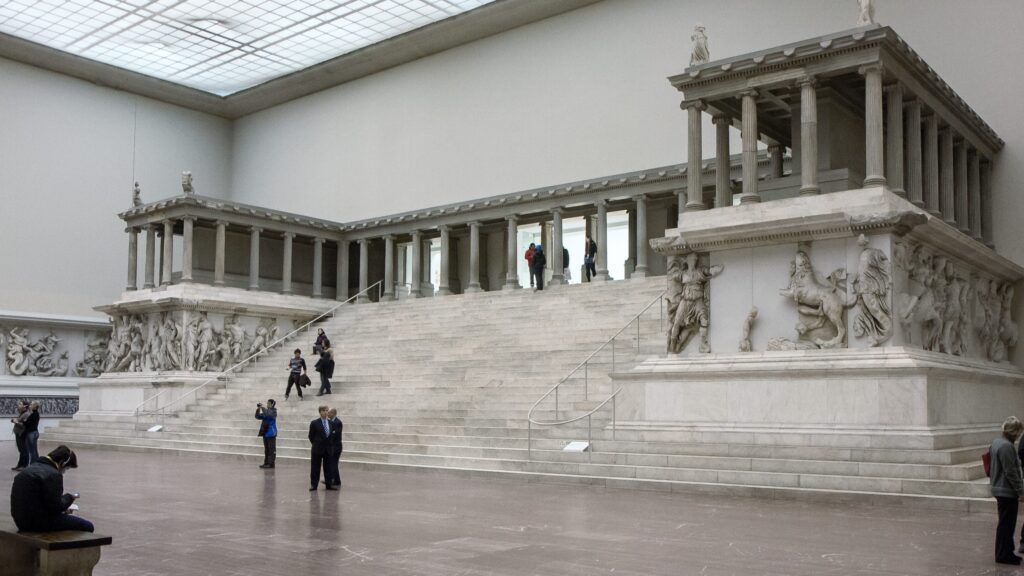Türkiye continues its legal and diplomatic struggle for the return of historical artifacts stolen in different periods. Especially in the 17th and 18th centuries, after the interest of European countries reached its peak in the field of archaeology, artifacts in geographies with rich archaeological reserves were almost plundered.
These geographies attracted the attention of Europeans of the time, who were looking for their roots or relied on archaeological data to lay claim to certain territories. With the interest of the countries and smugglers, many historical artifacts were smuggled out of Anatolia and other countries with rich histories, such as Egypt, which was part of the Ottoman territories, through different means.
Today, it is possible to see many artifacts smuggled from Anatolia or other parts of the world in places such as the British Museum in England, the Louvre Museum in France, the Pergamon Museum in Germany and the Metropolitan Museum in New York.
Türkiye continues to work within the framework of legal and diplomatic relations with the relevant countries to identify and ensure the return of artifacts illegally taken from its territory. In order to prove that the smuggled artifacts belong to these lands, documents from the Ottoman period, which are classified by the State Archives, both shed light on research and are presented as evidence to the authorities of the counterpart country.
In the return of artifacts where legal processes have been exhausted, it is aimed to complete the return processes by reminding the interlocutors of the ethical rules and by mutually developed goodwill bilateral relations.
In Türkiye, the Anti-Smuggling Department, established under the General Directorate of Cultural Heritage and Museums of the Ministry of Culture and Tourism, carries out the extradition processes in cooperation with the Ministry of Foreign Affairs and police units.
According to the reports of AA, in 2022, when many important artifacts were returned to the lands where they belonged, the head of Eros, the missing piece of the Sidamara sarcophagus, which was discovered 140 years ago in the ancient city of Sidamara in Karaman and exhibited in the Istanbul Archaeological Museums, was brought from the Victoria & Albert Museum in London and put back in its place.
The statue of Lucius Verus, Attis and Apollo statuettes, Kusura-type idol, düver terracotta slab and a 4-piece columnar sarcophagus, which were looted from ancient cities in Anatolia and smuggled to the USA, including artifacts that had been sought for their return since the 1970s, were brought back to Türkiye.
Also in the US, 28 artifacts, 14 of which were part of the antique art collection of billionaire Michael Steinhardt, were returned to Türkiye.
On the other hand, 5 gold coins seized in Istanbul and a stone artifact purchased by a Turkish collector from a foreign auction without knowing its origin were returned to Iraq, and artifacts including a 19th century Kaaba key, a metal key and lock, and a Kaaba key case were returned to Egypt.
As a result, 1121 artifacts in 11 different groups were returned in 2022 and started to be exhibited in the lands where they belong.
At the beginning of this year, 2,940 coins belonging to Türkiye that were seized in Burgas, Bulgaria while being smuggled into the country were returned to the Turkish authorities.
Twelve historical artifacts of Anatolian origin seized in the US were returned and brought to Türkiye at the end of March. The artifacts, consisting of a bronze bull cart (2 pieces), Roman military diploma, Neolithic Hacılar Mother Goddess figure, Urartian terracotta vase, Roman bronze bust crowned male head, Kilia type marble idol, oinokhoe originating from the ancient city of Hydai, stone figurine originating from Çatalhöyük, Roman tetrark statue head, statue head from Perge Theater, Bubon bronze arm and Septimius Severus statue, were taken under protection at the Antalya Museum.



The historical tomb stele, which was smuggled from the ancient city of Zeugma and found in Italy last year, was received at the Turkish Embassy in Rome at the end of April as a result of the collaborative efforts of the Italian gendarmerie, the Ministry of Foreign Affairs and the Ministry of Culture and Tourism.
The 1800-year-old tomb stele bears the figure of a woman and the words “Satornila, the wife who loves her husband, farewell”. The stele is expected to contribute to the biographies of the people and communities who lived in Zeugma.
In previous years, important artifacts such as the Boğazköy Sphinx, the Gypsy Girl Mosaic, the golden beak-mouthed jug and the winged seahorse brooch stolen from the museum were brought back to Türkiye.
Many artifacts that were taken abroad in different periods are still visited by millions of people in the world’s most important museums. Among these historical artifacts are the Lion of Cnidus, the Nereidler Monument, the Altar of Zeus (a very difficult artifact to steal, as seen in the photo above), the agora gate of the ancient city of Miletus, the Trysa Monument, the Old Fisherman, the Tombs of Selim II and Murat III and the tiles of the Mahmut I Library and various mosaics.
